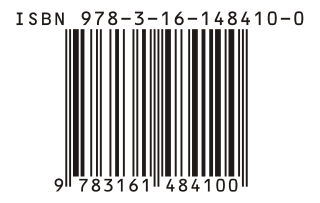
The Royal Regiment of Artillery, commonly referred to as the Royal Artillery (RA) and colloquially known as "The Gunners", is the artillery arm of the British Army. The Royal Regiment of Artillery comprises thirteen Regular Army regiments, King's Troop Royal Horse Artillery and five Army Reserve regiments.
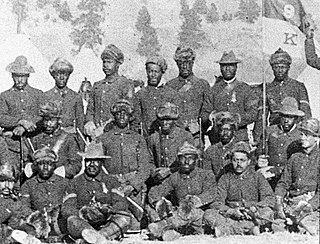
A troop is a military sub-subunit, originally a small formation of cavalry, subordinate to a squadron. In many armies a troop is the equivalent element to the infantry section or platoon. Exceptions are the Royal Horse Artillery and the US Cavalry, where a troop is a subunit comparable to an infantry company or artillery battery.

The Royal Regiment of Canadian Artillery is the artillery personnel branch of the Canadian Army.
The Royal Regiment of New Zealand Artillery is the artillery regiment of the New Zealand Army. It is effectively a military administrative corps, and can comprise multiple component regiments. This nomenclature stems from its heritage as an offshoot of the British Army's Royal Artillery. In its current form it was founded in 1947 with the amalgamation of the regular and volunteer corps of artillery in New Zealand. In 1958 in recognition of services rendered it was given the title the Royal Regiment of New Zealand Artillery.

The Royal Regiment of Australian Artillery, normally referred to as the Royal Australian Artillery (RAA), is a Regiment of the Australian Army descended from the original colonial artillery units prior to Australia's federation. Australia's first guns were landed from HMS Sirius and a small earthen redoubt built, near the present day Macquarie Place, to command the approaches to Sydney Cove. The deployment of these guns represents the origins of artillery in Australia. These and subsequent defences, as well as field guns, were operated by marines and the soldiers of infantry regiments stationed in Australia. The first Royal Artillery unit arrived in Australia in 1856 and began a succession of gunner units which ended with the withdrawal of the imperial forces in 1870 resulting in the raising of the Victorian Artillery Corps in Melbourne in 1870 and the New South Wales Artillery in Sydney in 1871. The First World War saw the raising of 60 field, 20 howitzer and two siege batteries along with the heavy and medium trench mortar batteries. Until 19 September 1962 the Australian Artillery was referred to as the 'Royal Australian Artillery', however on this date HM Queen Elizabeth II granted the RAA the title of 'The Royal Regiment of Australian Artillery'. The Regiment today consists of Regular and Reserve units.
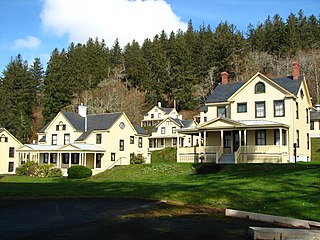
Fort Columbia State Park is a public recreation area and historic preserve at the site of former Fort Columbia, located on Chinook Point at the mouth of the Columbia River in Chinook, Washington. The 618-acre (250 ha) state park features twelve historic wood-frame fort buildings as well as an interpretive center and hiking trails. The park's grounds are located over a tunneled section of U.S. Route 101.

Fort Worden and accompanying Fort Worden Historical State Park are located in Port Townsend, along Admiralty Inlet in Washington state. It is on 433 acres that originally was a United States Army installation to protect Puget Sound. Fort Worden was named after U.S. Navy Rear Admiral John Lorimer Worden, commander of USS Monitor during its famous battle during the American Civil War.
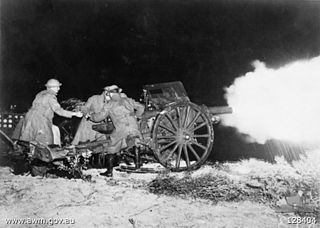
The 1st Regiment, Royal Australian Artillery is a close support regiment attached to the 7th Brigade at Enoggera Barracks in Queensland. The unit was formed in 1914 under the name 1st Australian Field Artillery Brigade, part of 1st Division Artillery during World War I and later served in World War II and the Vietnam War. It is currently re-equipping with M777A2 lightweight towed howitzers.
The 4th Regiment, Royal Australian Artillery is an artillery unit of the Australian Army. Currently it provides close artillery support to the 3rd Brigade and is based at Lavarack Barracks in Townsville, Queensland. The Regiment was raised in its current form in 1960 and is currently re-equipping with M777A2 lightweight towed howitzers. The Regiment deployed during Australia's commitment to the Vietnam War and has subsequently deployed to Singapore and East Timor.

The Canon de 155 Grande Puissance Filloux (GPF) mle.1917 was a WWI-era French-designed 155 mm gun used by the French Army and the United States Army during the first half of the 20th century in towed and self-propelled mountings.
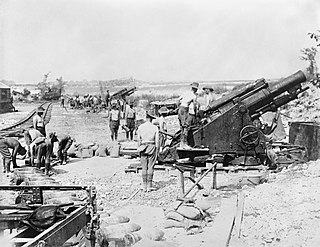
The Ordnance BL 9.2-inch howitzer was a heavy siege howitzer that formed the principal counter-battery equipment of British forces in France in World War I. It equipped a substantial number of siege batteries of the Royal Garrison Artillery. It remained in service until about the middle of World War II.

Fort Taber District or the Fort at Clark's Point is a historic American Civil War-era military fort on Wharf Road within the former Fort Rodman Military Reservation in New Bedford, Massachusetts. The fort is now part of Fort Taber Park, a 47-acre town park located at Clark's Point. Fort Taber was an earthwork built nearby with city resources and garrisoned 1861-1863 until Fort Rodman was ready for service.
III Brigade, Royal Horse Artillery , along with its sister IV Brigade, Royal Horse Artillery (T.F.), was a Royal Horse Artillery brigade of the Territorial Force that was formed in Egypt in April 1916 for the ANZAC Mounted Division.
A Battery, Honourable Artillery Company is a L118 light gun Battery that provides a reserve to 7th Parachute Regiment Royal Horse Artillery. Its predecessor was a horse artillery battery that was formed from Light Cavalry Squadron, HAC in 1891. It transferred to the Territorial Force in 1908 as artillery support for the London Mounted Brigade.
B Battery, Honourable Artillery Company was a horse artillery battery that was formed from the Field Artillery, HAC in 1899. It transferred to the Territorial Force in 1908 as artillery support for the South Eastern Mounted Brigade.
XIX Brigade, Royal Horse Artillery was a Royal Horse Artillery brigade of the Territorial Force that was formed by the Egyptian Expeditionary Force in Palestine in January 1917 for the Imperial Mounted Division. It served with the division thereafter in the Sinai and Palestine Campaign and was broken up after the end of World War I.
The Inverness-shire Royal Horse Artillery was a Territorial Force Royal Horse Artillery battery that was formed in Inverness-shire in 1908. It saw active service during the First World War in the Sinai and Palestine Campaign with the ANZAC Mounted Division from 1916 to 1918. A second line battery, 2/1st Inverness-shire RHA, served in the United Kingdom throughout the war. It was disembodied after the end of the war and was reconstituted as a Royal Field Artillery battery in 1920.
The Somerset Royal Horse Artillery was a Territorial Force Royal Horse Artillery battery that was formed in Somerset in 1908. It saw active service during the First World War in the Sinai and Palestine Campaign with the ANZAC Mounted Division from 1916 to 1918. A second line battery, 2/1st Somerset RHA, served on the Western Front with the 63rd Division from 1916 to 1918. It was disembodied after the end of the war and was not reconstituted in the Territorial Force in 1920.

2 Locating Regiment was an artillery regiment of the South African Artillery. The regiment provided divisional troops but was typically organized to allocate locating batteries to brigades.











